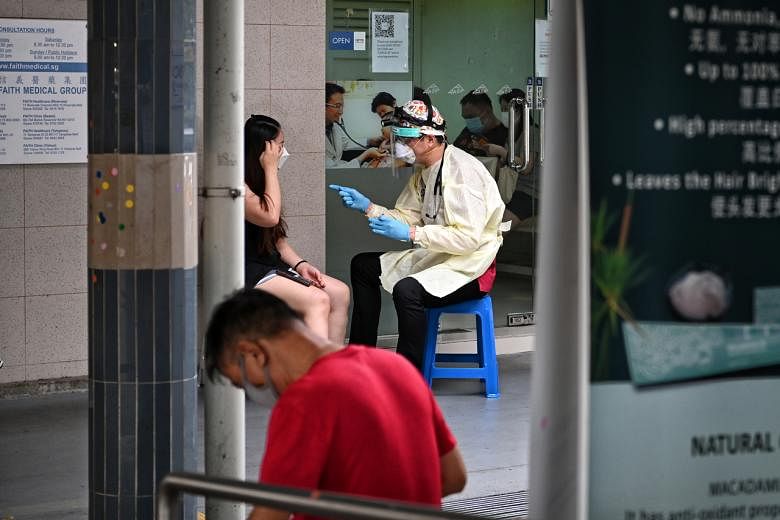SINGAPORE - Family doctors will play a key role as the nation shifts away from the traditional focus on illness-based hospital care to a more sustainable way of patient-centred preventive care that will focus on nipping diseases in the bud and keeping people healthy and out of hospital as much as possible.
Describing this as a major healthcare initiative called the Healthier SG strategy, Health Minister Ong Ye Kung said it is important to move now.
Speaking during the debate on his ministry's budget, he noted that more are suffering from high blood pressure and high cholesterol, for example.
This is happening as demand from a fast-ageing population will inevitably surge and healthcare expenditure is expected to triple in the coming decade to almost $27 billion in 2030.
Aside from age, Singaporeans young and old are getting less healthy generally, he pointed out.
As the population ages and people live longer, there may not be enough hospitals to feed the relentless demand at some point, particularly as many still see hospitals as the first resort the minute they need help with a chronic condition.
Getting a primary care doctor to lead the care for patients would help prevent diseases, as well as reduce or delay the likelihood of those with chronic conditions requiring hospital treatments. There are around 1,800 general practitioner (GP) clinics here.
To encourage people to focus on preventive care, the Ministry of Health (MOH) will study possibilities, including making recommended health screenings free or cost only a very nominal sum.
Mr Ong said: "Perhaps we can tap MediSave more for our care plan, or offer insurance premium discounts or vouchers if we diligently follow our care plans, or even better still, show good outcomes."
From next year, the MOH will be inviting each resident here to enrol with one GP or polyclinic doctor of their choice for all their care needs.
Mr Ong said: "After 10 years of foundation laying, plus a pandemic crisis, it is time for us to take the next big step. There is urgency to this because in the next 10 years, long after the Covid-19 dust has settled, we will have to tackle our biggest healthcare challenge since our nation began - the deteriorating health of the population."
So a person's one regular doctor will be the first point of contact when he needs help with a health issue.
GPs are nodes of trust, said Mr Ong. However, only three in five Singaporeans have a regular family doctor, he said.
"The other two tend to doctor-hop, go to doctor A for hypertension medicine, go to doctor B to get a medical certificate for cough and cold. So there is no one family doctor who knows our overall health condition and family health history well enough, to be able to see the link between different care episodes, even across different family members."
He said studies have shown that those who have a regular family doctor are generally healthier, and have fewer hospitalisation and emergency department visits.
Healthier SG involves regular, scheduled visits of at least once a year to a family doctor, said Mr Ong.
When we have a major illness, the doctor often refers us to one or more specialists or therapists, he said.
"But in a preventive care plan, the family doctor may refer us to a qigong class, to a brisk walking group, or a community farming club."
Having a regular family doctor also means there is someone to provide continuous care when a patient with more complex needs is discharged from hospital and referred back to the GP, for instance.
Mr Ong said MOH will probably start with people in their 40s and above because that is when chronic illnesses may start to set in.
The Government-funded initiative is a "sea change" in healthcare, said Adjunct Associate Professor Tan Tze Lee, president of the College of Family Physicians, Singapore.
"You're signing up with a GP or a polyclinic doctor to look after you, and you form a relationship with your doctor," he said. Once you settle on a doctor, you'll have to commit to see him or her for a period of time, for instance, a year, he added.
At a consultation, the doctor may discuss lifestyle changes that will help the patient manage his cholesterol levels or other issues.
Singapore has one of the highest life expectancies in the world, but one can spend his or her later years in bad health, said Prof Tan. The change will help to lengthen residents' healthspan, which is the number of years spent in good health.
This idea of having a chosen GP as the first contact has been around for decades. It is done in other countries such as the United Kingdom, New Zealand and Sweden, said Prof Tan.
The question is whether GPs here can provide this service or not, said Prof Tan who, as a family physician, has patients whom he has seen for 20 years. "And I think we can, if you look at how the GPs have stepped up to help fight Covid-19."
Mr Ong said the GP enrolment programme will be coordinated by the three healthcare clusters, each of which will look after up to 1.5 million residents. The clusters will partner various agencies such as the Health Promotion Board and Sport Singapore to help residents keep healthy.
This geographical approach will ensure that residents can get care near their homes. However, residents are free to enrol with a GP who is located far from their home, or make changes, for instance, when they move house.
MOH will provide the healthcare clusters with a pre-determined fee for every resident living in the region that they are looking after, Mr Ong said. This funding shift - from the current workload-based model - will give hospitals a natural incentive to try to keep residents healthy through preventive care.
For the Healthier SG strategy to succeed, MOH will support the GP clinics' capabilities, such as in telemedicine and IT systems. It will also be beefing up the workforce in the primary and community care sectors over the next few years, said Mr Ong.
In the coming months, it will consult all stakeholders on developing a primary care package that people will participate in as well as adhere to, he added. Details for this major strategy will be provided in a White Paper in the second half of the year.


